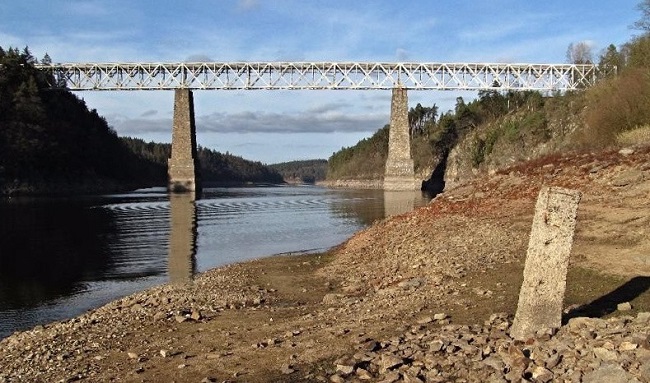
Zaorálek decided that the bridge over Orlík in Písek is a cultural monument
 |
Červená nad Vltavou – Minister of Culture Lubomír Zaorálek (ČSSD) dismissed the appeal filed by the Railway Administration (SŽ) against the designation of the railway bridge at Červená nad Vltavou in Písek as a cultural monument. Zaorálek thus confirmed the previous decision of the ministry from July. Today, Ivana Awwadová from the press department of the Ministry of Culture revealed this to ČTK. According to preservationists, the bridge cannot be demolished now, said Daniel Šnejd, the director of Czech Budějovice preservationists, to ČTK today.
SŽ must therefore construct a new bridge next to the old one, which it had already announced earlier. Previously, SŽ wanted to demolish the old bridge. The Railway Administration will continue preparing the construction of the new bridge, spokesperson Radka Pistoriusová informed ČTK today.
Zaorálek's decision is final. "The Minister of Culture found that the Ministry of Culture had gathered all the necessary documentation and concluded that it is a valuable railway steel truss bridge from the late 19th century. It is the very first railway bridge in the Czech lands that was built without scaffolding, only through quick assembly," Awwadová stated.
The Ministry of Culture received a proposal to declare the bridge a cultural monument in March. In the administrative proceedings, the bridge on the Tábor – Písek line was granted this status. SŽ filed an appeal against the decision, which Zaorálek dismissed, as stated on the website. According to the ministry, the fact that the bridge is a monument does not prevent the modernization of the line: the new bridge will be a few meters north of the original historical one. The city authorities of Písek, Milevsko, the South Bohemian regional office, and preservationists agreed that the bridge should become a monument.
"When a bridge is protected as a cultural monument, the preservation protection would first need to be revoked for the bridge to be demolished," Šnejd said.
South Bohemian governor Martin Kuba (ODS) is concerned whether the Ministry of Culture will have enough funds to maintain the bridge. "They must take care of it. I am afraid that with the costs associated with it, we will be looking at a bridge that will deteriorate. If the ministry has hundreds of millions to dedicate to the bridge, it is good news for the South Bohemian region, especially since the practical use of the bridge is very limited, as the land around it is privately owned, and the owner has not declared that they would allow the bridge to be used for a cycling route," Kuba said.
A new railway bridge over Orlík will be built by Metrostav for 543.6 million CZK. SŽ announced this in June and indicated that the company will remove the existing bridge. The work should be completed in October 2024, spokesperson Dušan Gavenda informed ČTK in June.
The original steel structure from 1889 does not meet requirements, and certain types of trains cannot be used on the line. Freight trains are not allowed, and the maximum speed is 30 kilometers per hour. A new reinforced concrete bridge will be created near the original one. With an arch span of 156 meters, it will be one of the largest in the Czech Republic, measuring 316.3 meters in length and with a height of 34.7 meters.
The original bridge, 280.2 meters long, 69.5 meters high, and weighing 940 tons, has not been significantly repaired until now. During the construction of the Orlík dam, only parts of the submerged pillars were reinforced, with minor repairs made in the 1970s and 1980s. The steel structure of the bridge does not meet speed and load requirements.
The bridge is on the Tábor - Písek line, near the village of Červená nad Vltavou, whose original part is submerged since the dam was built. The line runs above the Orlík reservoir. It is the only bridge over the Vltava on the railway between České Budějovice and Prague.
The railway bridge over the Vltava was constructed from 1886 to 1889 and has been in operation since November 20, 1889. At that time, it was the second highest bridge in Austria, behind the Trisana bridge in the Alps, which is 87 meters high. Červená nad Vltavou was one of the tourist attractions in the 1950s, but the local resort was submerged during the creation of the Orlík dam. Due to its flooding, the local Romanesque church had to be relocated to a higher site.
The English translation is powered by AI tool. Switch to Czech to view the original text source.
0 comments
add comment











